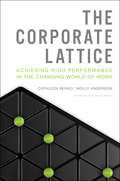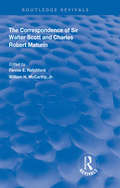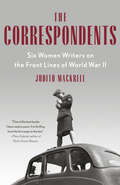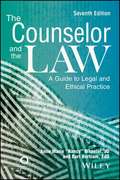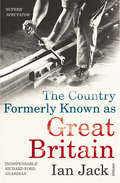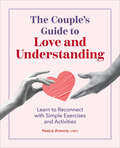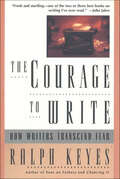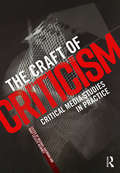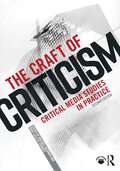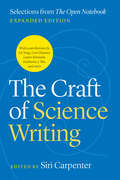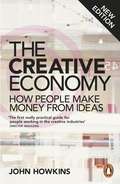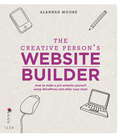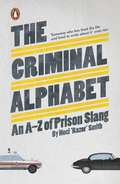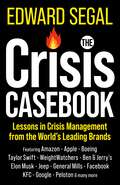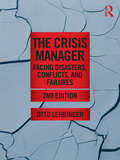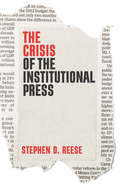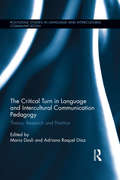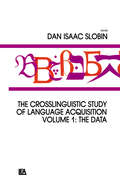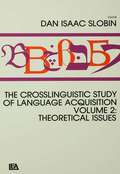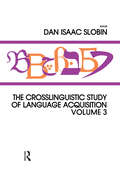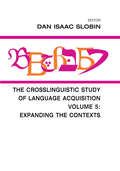- Table View
- List View
The Corporate Lattice
by Molly Anderson Cathleen BenkoWith roots planted firmly in the industrial age, the corporate ladder has been the metaphor used to describe the prevailing one-size-fits-all model for success. At its heart, the ladder is derived from inflexible, hierarchical, organization models in which prestige, individual rewards, information flow, power and influence are tied to the rung each employee occupies. Yet the workplace as we know it is in transition -- evolving away from the linear, one-size-fits-all model of the corporate ladder toward a multidimensional approach that Cathy Benko calls the corporate lattice.This book will serve to widen an organization's strategic lens, representing a fundamentally new way to work and run a company. It offers a framework to help senior leaders and HR directors harness the talent in their company in a way that provides a strategic advantage, not only for recruiting but also for achieving and maintain better individual performance.In the bestselling book Mass Career Customization (Harvard Business Press/2007), Cathy Benko and Deloitte provided the breakthrough MCC dashboard for understanding the important variables of individual employees' career-life profiles, but she also coined a new metaphor -- the corporate lattice -- as a way to think about the changed career landscape. This book delves much deeper into the power of the lattice for organizations, fully exploring its contours and applying it to real-life practice throughout a company.It explores how the corporate lattice model creates value by:1. Ensuring a flow of talent into and through the organization. 2. Increasing the efficiency of and return on organizational investments. 3. Improving financial and operating results through greater employee engagement.The three-part framework of the book presents specific ways managers and organizations can use The Corporate Lattice to manage talent, measure results, collaborate across teams, engage employees, and reor"
The Correspondence of Sir Walter Scott and Charles Robert Maturim (Routledge Revivals)
by Fannie E. Ratchford William H. McCarthyOriginally published in 1937, The Correspondence of Sir Walter Scott and Charles Robert Maturin contains twenty-two letters presenting a penetrating and vivid self-portrait of Sir Walter Scott. Scott's patronage of Maturin, this impecunious Irish author, giving him wise advice, lending encouragement in his work and at times badly needed financial assistance, extended over a period of twelve years to the time of Maturin's death, and his kind subsequent letters, written to Maturin's family, in the midst of his own great financial troubles, bring to a fitting close this single unit in Scott's rich social life. Since the two men never met, the whole relationship was built up through thier literary work and their letters to each other, displayed in this volume.
The Correspondents: Six Women Writers on the Front Lines of World War II
by Judith MackrellThe riveting, untold history of a group of heroic women reporters who revolutionized the narrative of World War II—from Martha Gellhorn, who out-scooped her husband, Ernest Hemingway, to Lee Miller, a Vogue cover model turned war correspondent. "Thrilling from the first page to the last." —Mary Gabriel, author of Ninth Street WomenOn the front lines of the Second World War, a contingent of female journalists were bravely waging their own battle. Barred from combat zones and faced with entrenched prejudice and bureaucratic restrictions, these women were forced to fight for the right to work on equal terms with men. The Correspondents follows six remarkable women as their lives and careers intertwined: Martha Gellhorn, who got the scoop on Ernest Hemingway on D-Day by traveling to Normandy as a stowaway on a Red Cross ship; Lee Miller, who went from being a Vogue cover model to the magazine&’s official war correspondent; Sigrid Schultz, who hid her Jewish identity and risked her life by reporting on the Nazi regime; Virginia Cowles, a &“society girl columnist&” turned combat reporter; Clare Hollingworth, the first English journalist to break the news of World War II; and Helen Kirkpatrick, the first woman to report from an Allied war zone with equal privileges to men. From chasing down sources and narrowly dodging gunfire to conducting tumultuous love affairs and socializing with luminaries like Eleanor Roosevelt, Picasso, and Man Ray, these six women are captured in all their complexity. With her gripping, intimate, and nuanced portrait, Judith Mackrell celebrates these courageous reporters who risked their lives for the scoop.
The Counselor and the Law: A Guide to Legal and Ethical Practice (Seventh Edition)
by Anne Marie Wheeler Burt BertramIn this seventh edition of The Counselor and the Law, each chapter has been updated to reflect changes in the 2014 ACA Code of Ethics, findings of recent court cases, and new federal and state legislation. Attorney Nancy Wheeler and Burt Bertram, a private practitioner and counselor educator, provide a comprehensive overview of the law as it pertains to counseling practice; an in-depth look at counselors legal and ethical responsibilities; and an array of risk management strategies. Written in a clear and engaging style, this text is not only a widely used and respected resource for students, it also provides real answers for clinicians who are challenged daily to act in the best interest of their clients while minimizing the chances of becoming involved in an ethical or legal complaint. The issues surrounding civil malpractice liability, licensure board complaints, confidentiality, duty to warn, suicide and threats of harm to self, professional boundaries, records and documentation, and managing a counseling practice are addressed in detail.
The Country Formerly Known as Great Britain
by Ian JackIn this selection from over twenty years of reporting and writing, Ian Jack sets out to deal with contemporary Britain - from national disasters to football matches to obesity - but is always drawn back in time, vexed by the question of what came first. In 'Women and Children First', watching the film Titanic leads into an investigation into the legend of Wallace Henry Hartley, the famous band leader of the doomed liner, while 'The 12.10 to Leeds', a magnificent report on the Hatfield rail crash, begins its hunt for clues in the eighteenth century in the search for those responsible. Further afield, he finds vestiges of a vanished Britain in the Indian subcontinent, meeting characters like maverick English missionary and linguist William Carey, credited with importing India's first steam engine.Full of the style, knowledge and intimacy that makes his work so special, this collection is the perfect introduction to the work of one of the country's finest writers.
The Couple's Guide to Love and Understanding: Learn to Reconnect with Simple Exercises and Activities
by Sonya Jensen LMFTBuild stronger communication and a brighter future together with this guide to reconnecting as a couple.Every couple has trouble connecting sometimes. We all have our own personalities and experiences that affect how we communicate, which means finding the best way to stay on the same page just takes a little practice! This workbook is filled with advice and activities to help you have honest conversations, overcome conflicts, and become closer and happier than ever.How to talk to your partner — Learn what it means to communicate effectively—like understanding each other's communication style, listening attentively, and keeping an open mind.Ongoing relationship skills — Try out checklists, journal entries, and exercises (with space for both of you to respond) that put your new knowledge into practice.You're in this together — Find guidance that works for any couple, no matter their background or lifestyle, along with stories from other couples that have used these techniques with great success!Grow closer to your partner through this supportive couple's therapy workbook.
The Courage to Write: How Writers Transcend Fear
by Ralph Keyes“One of the best books about the writing profession ever published.” ―The Fresno BeeKatherine Anne Porter called courage “the first essential” for a writer. “I have to talk myself into bravery with every sentence,” agreed Cynthia Ozick, “sometimes every syllable.” E. B. White said he admired anyone who “has the guts to write anything at all.”In The Courage to Write, Ralph Keyes, an author who has taught writing for more than thirty years, assures us that anxiety is felt by writers at every level, especially when they dare to do their best. He describes the sequence of “courage points” through which all writers must pass, from the challenge of identifying a worthwhile project to the mixture of pride and panic they feel when examining a newly published book or article.Keyes also offers specifics on how to root out dread of public “performance” and of the judgment of family and friends, make the best use of writers’ workshops and conferences, and handle criticism of works in progress. Throughout, he includes the comments of many accomplished writers—Pat Conroy, Amy Tan, Rita Dove, Isabel Allende, and others—on how they transcended their own fears to produce great works.“Fresh and startling—one of the two or three best books on writing I’ve ever read.” ―John Jakes, #1 New York Times-bestselling author“Keyes has written thoughtfully and well about the roles of fear and courage in the writing process. Bravo!” —Lawrence Block, New York Times-bestselling author
The Covid-19 Pandemic as a Challenge for Media and Communication Studies (Routledge Research in Cultural and Media Studies)
by Katarzyna Kopecka-PiechThis truly interdisciplinary volume brings together a diverse group of scholars to explore changes in the significance of media and communication in the era of pandemic. The book answers two interrelated questions: how media and communication reality changed during the first wave of the COVID-19 pandemic, and how media and communication were effectively studied during this time. The book presents changes in media and communication in three areas: media production, media content, and media usage contexts. It then describes the theoretical and practical, methodological, technical, organizational, and ethical challenges in conducting research in circumstances of sudden change in research conditions, emergency situations and developing crises. Drawing on various theoretical studies and empirical research, the volume illustrates the principles and results of applying diverse research methods to the changing role of media in a pandemic and offers good practices and guidance to address the problems in implementing research projects in a time of sudden difficulties and challenges. This diverse and interdisciplinary book will be of significance to scholars and researchers in media studies, communication studies, research methods, sociology, anthropology, and cultural studies.
The Craft of Criticism: Critical Media Studies in Practice
by Mary Celeste Kearney Michael KackmanWith contributions from 30 leading media scholars, this collection provides a comprehensive overview of the main methodologies of critical media studies. Chapters address various methods of textual analysis, as well as reception studies, policy, production studies, and contextual, multi-method approaches, like intertextuality and cultural geography. Film and television are at the heart of the collection, which also addresses emergent technologies and new research tools in such areas as software studies, gaming, and digital humanities. Each chapter includes an intellectual history of a particular method or approach, a discussion of why and how it was used to study a particular medium or media, relevant examples of influential work in the area, and an in-depth review of a case study drawn from the author's own research. Together, the chapters in this collection give media critics a complete toolbox of essential critical media studies methodologies.
The Craft of Criticism: Critical Media Studies in Practice
by Mary Celeste Kearney Michael KackmanWith contributions from 35 leading media scholars, this collection provides a comprehensive overview of the main methodologies of critical media studies.Fully revised and updated throughout, the chapters in this second edition address various methods of textual analysis, as well as reception studies, policy studies, production studies, and contextual, multi-method approaches, like intertextuality and cultural geography. Film and television are at the heart of the collection, which also addresses digital technologies and new research tools in such areas as software studies, gaming, and social media. Each chapter includes an intellectual history of a particular method or approach, a discussion of why and how it was used to study a particular medium or media, relevant examples of influential work in the area, and an in-depth review of a case study drawn from the author’s own research.Together, the chapters in this collection give media scholars and critics a complete toolbox of essential critical media studies methodologies.
The Craft of Science Writing: Selections from “The Open Notebook,” Expanded Edition (Chicago Guides to Writing, Editing, and Publishing)
by Siri CarpenterA deeply sourced, inclusive guide to all aspects of science writing with contributions from some of the most skilled and award-winning authors working today. Science writing has never been so critical to our world, and the demands on writers have never been greater. On any given day, a writer might need to explain the details of AI, analyze developments in climate change research, or serve as a watchdog helping to ensure the integrity of the scientific enterprise. At the same time, writers must spin tales that hook and keep readers, despite the endless other demands on their attention. How does one do it? The Craft of Science Writing is the authoritative guide. With pieces curated from the archives of science writers’ go-to online resource, The Open Notebook, this book explores strategies for finding and shaping story ideas, pitching editors, and building a specialty in science writing. It delves into fundamental skills that every science writer must learn, including planning their reporting; identifying, interviewing, and quoting sources; organizing interview notes; and crafting stories that engage and inform audiences. This expanded edition includes new introductory material and nine new essays focusing on such topics as how to establish a science beat, how to find and use quotes, how to critically evaluate scientific claims, how to use social media for reporting, and how to do data-driven reporting. In addition, there are essays on inclusivity in science writing, offering strategies for eradicating ableist language from stories, working with sensitivity readers, and breaking into English-language media for speakers of other languages. Through interviews with leading journalists offering behind-the-scenes inspiration as well as in-depth essays on the craft offering practical advice, readers will learn how the best science stories get made, from conception to completion. Contributors: Humberto Basilio, Siri Carpenter, Jeanne Erdmann, Dan Ferber, Tina Casagrand Foss, Geoffrey Giller, Laura Helmuth, Jane C. Hu, Alla Katsnelson, Roxanne Khamsi, Betsy Ladyzhets, Jyoti Madhusoodanan, Amanda Mascarelli, Robin Meadows, Kate Morgan, Tiên Nguyễn, Michelle Nijhuis, Aneri Pattani, Rodrigo Pérez Ortega, Mallory Pickett, Kendall Powell, Tasneem Raja, Sandeep Ravindran, Marion Renault, Julia Rosen, Megha Satyanarayana, Christina Selby, Knvul Sheikh, Abdullahi Tsanni, Alexandra Witze, Katherine J. Wu, Wudan Yan, Ed Yong, Rachel Zamzow, Sarah Zhang, and Carl Zimmer
The Creative Economy: How People Make Money from Ideas
by John HowkinsCreativity is the fastest growing business in the world.Companies are hungry for people with ideas - and more and more of us want to make, buy, sell and share creative products. But how do you turn creativity into money? In this newly rewritten edition of his acclaimed book, leading creative expert John Howkins shows what creativity is, how it thrives and how it is changing in the digital age. His key rules for success include:Invent yourself. Be unique.Own your ideas. Understand copyright, patents and IP laws. Treat the virtual as real, and vice versa.Learn endlessly: borrow, reinvent and recycle.Know when to break the rules.Whether in film or fashion, software or stories, by turning ideas into assets anyone can make creativity pay.
The Creative Person's Website Builder: How to Make a Pro Website Yourself Using Word Press and Other Easy Tools
by Alannah MooreYour website is the face that your creative endeavours show to the world, and you owe it to yourself to make it the most inviting and user-friendly site on the web. With The Creative Person's Website Builder, you'll learn how to create a site from scratch, or massively improve what you already have, quickly and economically.Tailor-made for creative professionals, artists and entrepreneurs, this book offers step-by-step solutions to constructing a site that looks great, works smoothly, and drives visitor numbers up.
The Criminal Alphabet: An A-Z of Prison Slang
by Noel 'Razor' Smith'I have spent almost 33 of the last 53 years in and out of prison, but mainly in. I was a juvenile offender back in the mid 1970s and went on to become an adult prisoner in the 1980s and beyond. My shortest prison sentence was 7 days (for criminal damage) and my longest sentence was life (for bank robbery and possession of firearms). I have 58 criminal convictions for everything from attempted theft to armed robbery and prison escape, and I was a career criminal for most of my life. What I do not know about criminal and prison slang could be written on the back of a postage stamp and still leave room for The Lord's Prayer ...'From ex-professional bank robber and bestselling author Noel Smith, this is the most authoritative dictionary of criminal slang out there - and an unmissable journey, through words, into the heart of the criminal world.
The Crisis Casebook: Lessons in Crisis Management from the World’s Leading Brands
by Edward SegalIt doesn't matter who you are or what business you're in, you are never far from a crisis. Edward Segal has profiled over 700 crises in his popular column on Forbes.com since 2020, from those affecting businesses and organizations to global celebrities and royalty. Here he builds on that bank of real-life stories, developing the lessons and adding new unseen material, to reveal how global organizations and high-profile individuals have prevented, managed, and recovered from a variety of crisis situations.According to The Conference Board's C-Suite Outlook 2023, less than half of surveyed corporate executives around the world said they were ready for a pandemic or global health crisis; only 41% are prepared for cybersecurity crises; and only 39% have planned for financial instability. And these are just the tip of the iceberg of crisis triggers with others including recession, extreme climate events, terrorism, lawsuits, accidents, and allegations of sexual abuse. In The Crisis Casebook, Edward Segal expertly recounts the good, the bad, and the ugly ways companies and people have managed a variety of crisis situations showing you how to avoid crisis management mistakes that could damage your company's reputation, profits, and future - and your career.
The Crisis Casebook: Lessons in Crisis Management from the World’s Leading Brands
by Edward SegalIt doesn't matter who you are or what business you're in, you are never far from a crisis. Edward Segal has profiled over 700 crises in his popular column on Forbes.com since 2020, from those affecting businesses and organizations to global celebrities and royalty. Here he builds on that bank of real-life stories, developing the lessons and adding new unseen material, to reveal how global organizations and high-profile individuals have prevented, managed, and recovered from a variety of crisis situations.According to The Conference Board's C-Suite Outlook 2023, less than half of surveyed corporate executives around the world said they were ready for a pandemic or global health crisis; only 41% are prepared for cybersecurity crises; and only 39% have planned for financial instability. And these are just the tip of the iceberg of crisis triggers with others including recession, extreme climate events, terrorism, lawsuits, accidents, and allegations of sexual abuse. In The Crisis Casebook, Edward Segal expertly recounts the good, the bad, and the ugly ways companies and people have managed a variety of crisis situations showing you how to avoid crisis management mistakes that could damage your company's reputation, profits, and future - and your career.
The Crisis Manager: Facing Disasters, Conflicts, and Failures (Lea’s Communication Series)
by Otto LerbingerResponding to the era of crises in which we now live, The Crisis Manager offers wise counsel for anticipating and responding to crises as well as taking the steps required to reduce the impact of these events. Spotlighting the reality of crisis at levels ranging from local to global, author Otto Lerbinger helps readers understand the approaches and ways of thinking required for successful crisis management in today's world. As no organization or individual is immune from crisis, he guides managers to make good decisions under conditions of high uncertainty, and to consider the interests not only of stockholders but also of a wide variety of stakeholders. With a focus on the threat of crises to an organization's most valuable asset - its reputation - The Crisis Manager covers: Preparation for crisis, including crisis communication planning Physical crises - natural, biological, and technological "Human climate" crises, stemming from targeted attacks on an organization's policies, actions, or physical holdings Crises due to management failure, including mismanagement, skewed values, deception, and misconduct New to this second edition are the use of social media in crisis management, and chapters on image restoration strategies and crises stemming from mismanagement, as well as a comprehensive updating of the entire work. Real-world case studies provide examples of what worked and what did not work, and the reasons why. Written for present and future crisis managers in all types of businesses and organizations, this resource will be required reading for students in public relations, business, and management, as it prepares them for their crucial roles as decision makers.
The Crisis of Journalism Reconsidered
by Jeffrey C. Alexander Alexander, Jeffrey C. and Breese, Elizabeth Butler and Luengo, María Elizabeth Butler Breese María LuengoThis collection of original essays brings a dramatically different perspective to bear on the contemporary 'crisis of journalism'. Rather than seeing technological and economic change as the primary causes of current anxieties, The Crisis of Journalism Reconsidered draws attention to the role played by the cultural commitments of journalism itself. Linking these professional ethics to the democratic aspirations of the broader societies in which journalists ply their craft, it examines how the new technologies are being shaped to sustain value commitments rather than undermining them. Recent technological change and the economic upheaval it has produced are coded by social meanings. It is this cultural framework that actually transforms these 'objective' changes into a crisis. The book argues that cultural codes not only trigger sharp anxiety about technological and economic changes, but provide pathways to control them, so that the democratic practices of independent journalism can be sustained in new forms.
The Crisis of the Institutional Press
by Stephen D. ReeseAs polarized factions in society pull apart from economic dislocation, tribalism, and fear, and as strident attacks on the press make its survival more precarious, the need for an institutionally organized forum in civic life has become increasingly important. Populist challenges amplified by a counter-institutional media system have contributed to the long-term decline in journalistic authority, exploiting a post-truth mentality that strikes at its very core. In this timely book, Stephen Reese considers these threats through a new conception of the ‘hybrid institution’: an idea that extends beyond the traditional newsroom, and distributes across multiple platforms, national boundaries, and social actors. What is it about the institutional press that we value, and around what normative standards could a hybrid institution emerge? Addressing these questions, Reese highlights how this is no time to be passive but rather to articulate and defend greater aspirations. The institutional press matters more than ever: a reality that must be communicated to a public that depends on it. The Crisis of the Institutional Press is an essential resource for students and scholars of journalism, media and communication.
The Critical Turn in Language and Intercultural Communication Pedagogy: Theory, Research and Practice (Routledge Studies in Language and Intercultural Communication)
by Adriana Raquel Díaz Maria DasliThis edited research volume explores the development of what can be described as the ‘critical turn’ in intercultural communication pedagogy, with a particular focus on modern/foreign language education. The main aim is to trace the realisations of this critical turn against a background of unequal power relations, and to illuminate the role that radical culture educators can play in the making of a more democratic and egalitarian social order. The volume takes as a starting point the idea that criticality draws on a number of intellectual traditions, which do not always focus on social and political critique, and argues that because ideological hegemony impacts on the meanings that people create and share, intercultural communication pedagogy ought to locate itself within wider socio-political contexts. With reference points drawn from critical and transnational social theory, critical pedagogy and intercultural theory, contributors to this volume provide readers with powerful ways that show how this can be achieved, and together assess the impact that their understanding of criticality can make on modern/foreign language education. The volume is divided into three major parts, namely: ‘theorising critically’, ‘researching critically’ and ‘teaching critically’.
The Crosslinguistic Study of Language Acquisition Volume 1: the Data
by Dan Isaac SlobinAn essential handbook for professionals and advanced students in the field. Volume 1 contains comprehensive studies on the acquisition of 15 different languages (from ASL to Samoan) -- written by top researchers on each topic. Volume 2 concentrates on theoretical issues, emphasizing current linguistic and psycholinguistic research. Unique in its approach toward individual languages and in its comparative perspective, this book is a hallmark of a rapidly growing area of interdisciplinary, international research.
The Crosslinguistic Study of Language Acquisition: Volume 2: Theoretical Issues
by Dan Isaac SlobinSee Volume I (0-89859-367-0) for full description and TOC.
The Crosslinguistic Study of Language Acquisition: Volume 3
by Dan Isaac SlobinExtending the tradition of this series, which has become a standard reference work in language acquisition, this volume contains chapters on seven more languages, including a section on ergative languages. Languages in this volume include: Georgian; Greenlandic; K'iche Mayan; Warlpiri; Mandarin; Scandinavian and Sesotho.
The Crosslinguistic Study of Language Acquisition: Volume 4
by Dan Isaac SlobinContinuing the tradition of this series, which has become a standard reference work in language acquisition, Volume 4 contains chapters on three additional languages/language groups--Finnish, Greek, and Korean. The chapters are selective, critical reviews rather than exhaustive summaries of the course of development of each language. Authors approach the language in question as a case study in a potential crosslinguistic typology of acquisitional problems, considering those data which contribute to issues of general theoretical concern in developmental psycholinguistics and linguistic theory. Each chapter, therefore, provides the following: * Grammatical Sketch of Language. Brief grammatical sketch of the language or language group, presenting those linguistic facts which are relevant to the developmental analysis. * Sources of Evidence. Summary of basic sources of evidence, characterizing methods of gathering data, and listing key references. * Overall Course of Development. Brief summary of the overall course of development in the language or language group, giving an idea of the general problems posed to the child in acquiring a language of this type, summarizing typical errors, domains of relatively error-free acquisition, and the timing of acquisition--areas of the grammar that show relatively precocious or delayed development in crosslinguistic perspective. * Data. Specific developmental aspects of the language examined in depth, depending on each individual language and available acquisition data. * Conclusions. An interpretive summary of theoretical points raised above, attending to general principles of language development and linguistic organization suggested by the study of a language of this type, plus comparisons with development of other languages.
The Crosslinguistic Study of Language Acquisition: Volume 5: Expanding the Contexts
by Dan Isaac SlobinIn this final volume in the series, the contributors attempt to "expand the contexts" in which child language has been examined crosslinguistically. The chapters build on themes that have been touched on, anticipated, and promised in earlier volumes in the series. The study of child language has been situated in the disciplines of psychology and linguistics, and has been most responsive to dominant issues in those fields such as nativism and learning, comprehension and production, errors, input, and universals of morphology and syntax. The context has primarily been that of the individual child, interacting with a parent, and deciphering the linguistic code. The code has been generally treated in these volumes as a system of morphology and syntax, with little attention to phonology and prosody. Attention has been paid occasionally to the facts that the child is acquiring language in a sociocultural setting and that language is used in contexts of semantic and pragmatic communication. In addition, there has been a degree of attention paid to the interactions between language and cognition in the process of development. As for individual differences between children, they have been discussed in those studies where they could not be avoided, but such variation has rarely been the focus of systematic attention. Differences between individual languages have been of great interest, but these differences have not often been placed in a framework of systematic typological variation. And although languages and their grammars change over time, the focus of attention on the individual child learner has generally led to neglect of explanatory principles that are best found on the level of linguistic diachrony, rather than the level of innate ideas or patterns of learning and cognition in the individual child. The chapter authors seek to explore these neglected contexts in more depth.
